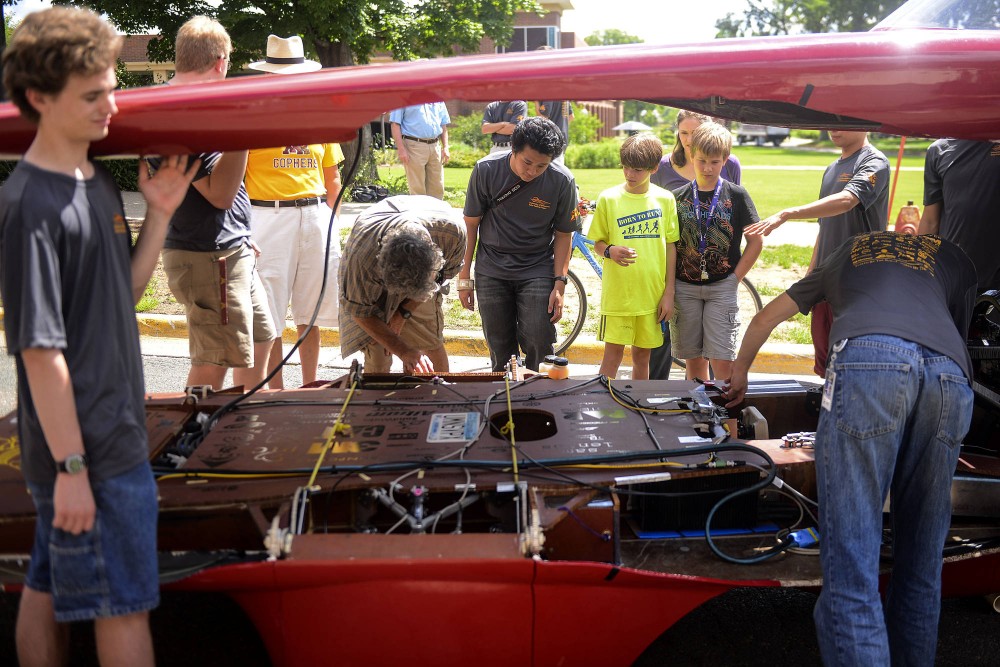On any given race day, a team of University of Minnesota engineering students will race on two hours’ worth of battery charge.
After that, they’ll be at the sun’s mercy.
Starting Monday, about 17 engineering students will put their 10th-generation solar car, Centaurus III, to the test when they depart for the American Solar Challenge, an eight-day race of more than 1,700 miles from Austin, Texas, to Minneapolis.
Under fittingly sunny skies last week, the University of Minnesota Solar Vehicle Project team showcased the sleek, cherry-red vehicle it built and designed –– and will soon race in the cross-country competition. The students will face teams from 22 other schools from the United States and countries like Iran, India, Canada and Puerto Rico.
The one-person, three-wheeled vehicle has been upgraded from its most recent competition in 2012 with an improved aerodynamics and mechanical systems, said electrical engineering senior Mitchell Rogalsky.
The 376-pound car sits low to the ground at a height of about 3 feet — but that’s a welcome stabilizing force for a vehicle that’s susceptible to strong gusts of wind, as it weighs a fraction of what an average car does.
“The car is lighter and more maneuverable then a normal car,” said Jacob Herbers, a recently graduated mechanical engineering student.
It’s covered with corrugated solar cells that capture and convert the sun’s energy into electricity and power the car’s battery.
Centaurus III is worth between $1 and $1.5 million, Rogalsky said. Sponsors including the College of Science and Engineering, 3M, Altium and Delta Airlines helped fund the project through cash donations and donated materials, parts and software.
It was a time crunch rather than a scarcity of resources that has put the team in a pinch, said Bryan Dean, a mechanical engineering senior and project lead who has driven in previous solar challenges.
Since disassembling Centaurus III after its 2012 competition, the students had a year to redesign the car and another year to reconstruct it. All of the plans, models and designs were student-made, Dean said.
“It’s a lot of fun to make something out of nothing,” he said. “We have a limited amount of time — two years isn’t much to build a brand-new car from scratch.”
Inside a tool-strewn garage, a total of 50 students have spent between 30,000 and 50,000 hours on the project.
“This is where the magic happens,” Rogalsky said inside the team’s shop, where a display case shows off a collection of trophies, including a third-place prize in the 2010 American Solar Challenge and a fourth-place finish in last year’s World Solar Challenge in Australia.
Many of the students have worked more than 40 hours a week in the shop, he said.
“I’m here more than I’m at my full-time job,” Rogalsky said. “I’ve learned more from this than in class, which is theory instead of application.”
Employers prefer students who participate in solar challenges, said Alex Nelson, a recently graduated electrical engineering student, since they enter the field with hands-on knowledge.
“For an entry-level position, it means a lot more to employers than a master’s degree,” he said.
Four sub-groups comprise the Solar Vehicle Project: an aerodynamics team to reduce the car’s drag, an array team to handle its solar cells, an electrical team to manage how the vehicle stores and uses solar energy, and a mechanical team to ensure its safety and efficiency.
Simulating aerodynamic friction, mounting solar panels and building a motor from scratch are among the calculations and “extensive modifications” students made over their two years of work, said adviser Philip Cohen, an electrical and computer engineering professor.
“They’re using a lot of what they learn in their coursework,” he said. “It’s pretty impressive what they do.”
The students are also in the process of designing their other car, Daedalus — which competes in alternation with Centaurus III — for the 2015 World Solar Challenge.
In the week leading up to this year’s American Solar Challenge, they expect an ongoing list of last-minute tune-ups.
“We never stop working on the car,” Nelson said.
Once the race is underway on July 21, one of four rotating drivers will take four- to six-hour shifts driving the Centaurus III from about 8 a.m. to 5 p.m.
Before and after driving, the students will be allowed to charge the car for two hours at a time and apply any new features or fixes before the next day’s stretch.
Once the vehicle’s initially full battery depletes, the sun alone will provide the car with power, so efficiency and strategy are crucial.
The trick, team members said, is balancing speed while rationing out battery power over the course of the race. They’ll select their speed on a day-by-day basis, depending on the weather and other ever-changing variables.
“It’s a gamble. … It’s pretty intense [and] it takes a dedicated person,” Dean said. “But it’s a light, sporty, fun car to drive.”


